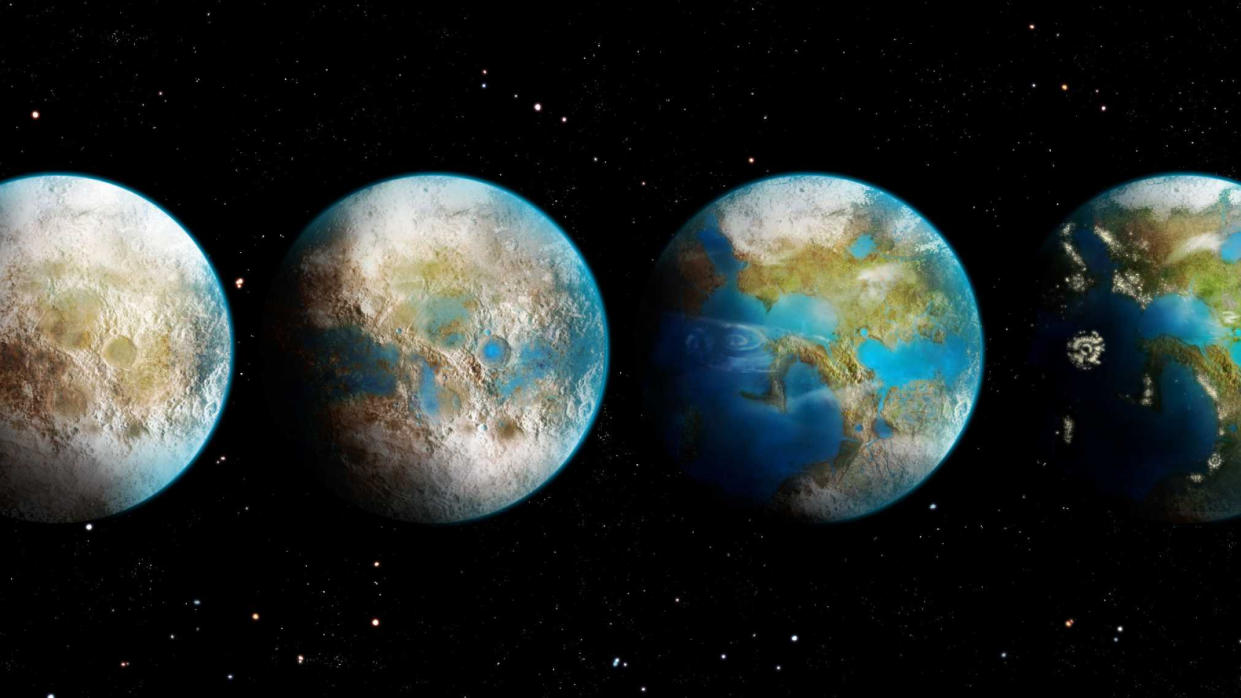If alien terraforming emits greenhouse gases, our telescopes could detect it

If aliens wrap their planets in potent greenhouse gases like we do, we'd be able to tell.
That's according to a recent thought experiment in which scientists identified five "artificial" greenhouse gases that, if abundant enough, can be spotted in the atmospheres of certain exoplanets using existing technology, including the James Webb Space Telescope (JWST).
The gases, which include fluorinated versions of methane, ethane, propane, on Earth are known to be some of the most potent and persistent heat-trapping gases emitted by humans during various industrial manufacturing processes, like those used to produce semiconductors, for instance. Because these substances don't naturally form in large quantities — if we're going by Earth chemistry, at least — spotting them in an exoplanet's air would signal the presence of technologically-advanced species, scientists say.
On Earth, these gases are dangerous pollutants, and limiting their emissions is crucial to combat human-driven climate change. Their presence in an alien atmosphere may not necessarily be bad news, however.
"For us, these gases are bad because we don't want to increase warming," study lead author Edward Schwieterman of the University of California, Riverside, said in a recent statement. "But they'd be good for a civilization that perhaps wanted to forestall an impending ice age or terraform an otherwise-uninhabitable planet in their system, as humans have proposed for Mars."
Related: NASA space telescope finds Earth-size exoplanet that's 'not a bad place' to hunt for life
Such intentional climate modification to create an Earth-like environment is known as terraforming. The idea of terraforming Mars has sprouted in almost every sci-fi story, and, in recent years, scientists too have proposed similar approaches to support long-term colonization. Ideas to warm Mars include thawing some of the ice in the planet's poles and releasing carbon dioxide trapped in its surface to buttress the planet's thin atmosphere like a warm blanket. Although, some remain skeptical about the concept. For instance, Paul Sutter, an astrophysicist at SUNY Stony Brook and Space.com contributor, wrote in a 2021 article that this type of terraforming effort probably won't work, crucially because Mars likely doesn't host enough carbon dioxide to trigger a decent warming trend.
More recently, Schwieterman and his colleagues simulated a planet in the TRAPPIST-1 system, which is a family of seven rocky planets about 40 light-years away from Earth in the constellation Aquarius; several of them are considered potentially habitable. The planet, TRAPPIST-1f, for example, circles its host star every nine days within its habitable zone.
If aliens were to terraform such a planet, the researchers found the JWST could identify the five greenhouse gases. One among them, sulfur hexafluoride, has a warming potential that exceeds carbon dioxide by 23,500 times. Minuscule amounts of this gas, which has a lifetime of at least 1,000 years, is sufficient to thaw an icy planet to a point where life-supporting liquid water flows on its surface, the researchers say. (Life as we know it, to be clear).
"The long lifetime makes these gases excellent technosignatures to systematically search for in comparison to shorter-lived signals," study co-author Daniel Angerhausen of ETH Zürich said in another statement. "These signatures might even outlive their civilization if their geoengineering experiments were to fail."
Other similar, fluorinated gases may hover in an Earth-like atmosphere for up to 50,000 years, so "they wouldn't need to be replenished too often for a hospitable climate to be maintained," Schwieterman said in the statement.
Related Stories:
— Young 'cotton candy' exoplanet the size of Jupiter may be shrinking into a super-Earth
— Earth-size planet discovered around cool red dwarf star shares its name with a biscuit
— Star blows giant exoplanet's atmosphere away, leaving massive tail in its wake
That means if extraterrestrial life in frigid planets beyond our solar system pumps a bunch of greenhouse gases into their atmospheres to make their worlds more habitable, our existing telescopes might be able to spot them. Even if only one out of every million gas molecules sucked in infrared radiation from its host star, it would produce a tell-tale signature detectable with the JWST and other space-based telescopes, Schwieterman and his team found.
"You wouldn't need extra effort to look for these technosignatures, if your telescope is already characterizing the planet for other reasons," said Schwieterman. "And it would be jaw-droppingly amazing to find them."
These findings are described in a paper published June 25 in The Astrophysical Journal.

